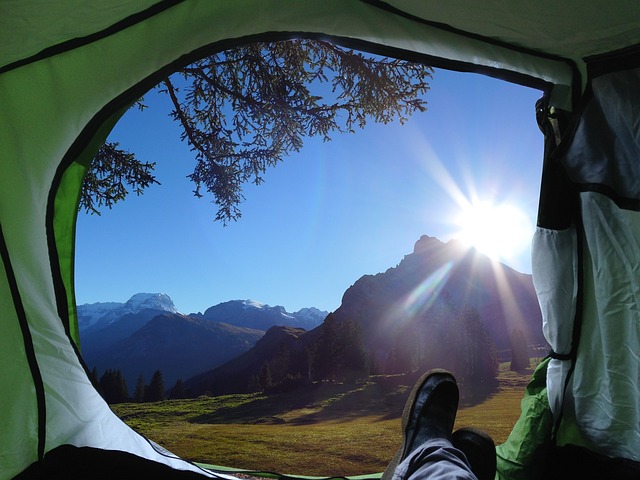When it comes to camping, getting a good night’s sleep is crucial. And while there are many factors that can affect the quality of your sleep, one of the most important is having the right sleeping gear. In particular, a high-quality sleeping bag can make all the difference in keeping you warm, comfortable, and protected from the elements. But do you really need a sleeping bag for camping?
Yes, a sleeping bag is essential for camping as it provides insulation, comfort, and protection from the elements for a restful night’s sleep.
In this article, I’ll explore the benefits of sleeping bags for camping, as well as some alternatives and tips for choosing the right one for your needs.
What is a Sleeping Bag?
A sleeping bag is a type of insulated bedding designed for use while camping or traveling. It typically consists of an outer shell made from durable, water-resistant materials like nylon or polyester and an inner lining made from soft, comfortable fabrics like cotton or flannel. In between these layers, sleeping bags contain insulating materials like down or synthetic fibers that help to trap and retain body heat. This insulation is what makes sleeping bags so effective at keeping you warm and comfortable, even in cold or damp conditions. There are many different types of sleeping bags available, each with its own unique features and benefits, and choosing the right one can make all the difference in ensuring a comfortable and restful night’s sleep while camping.
Reasons why you need a Sleeping Bag for Camping
There are several reasons why a sleeping bag is an essential piece of gear for camping. Here are a few of the main benefits:
- Insulation: One of the primary reasons to use a sleeping bag for camping is to provide insulation and keep you warm. Sleeping bags are designed to trap and retain body heat, which is especially important when camping in cooler temperatures. This insulation can help prevent hypothermia and ensure a restful night’s sleep.
- Comfort: Sleeping bags are designed to provide a comfortable and supportive sleeping surface, even on rough or uneven ground. They are often made from soft, breathable fabrics that feel good against your skin and can help regulate your body temperature for optimal comfort.
- Protection: Sleeping bags can provide protection from the elements, such as wind, rain, and snow. They can also help keep insects and other pests at bay, providing a barrier between you and the outside world.
- Convenience: Sleeping bags are easy to pack and transport, making them a convenient option for camping trips. They can be rolled up or compressed down to a compact size, taking up minimal space in your backpack or vehicle.
Overall, a good quality sleeping bag is an essential piece of camping gear that can make all the difference in ensuring a safe, comfortable, and restful night’s sleep in the great outdoors.
Factors to Consider when Choosing a Sleeping Bag
When choosing a sleeping bag for camping, there are several factors to consider to ensure that you get the best possible option for your needs. Here are 5 of the most important factors to keep in mind:
1. Temperature Rating
Sleeping bags are usually rated for temperature, with the most common ratings being for “comfort” and “lower limit”. The comfort rating is the lowest temperature at which a person is likely to be comfortable sleeping in the bag, while the lower limit rating is the lowest temperature at which a person can sleep in the bag without risking hypothermia. Consider the temperature rating of the sleeping bag based on the climate conditions you will be camping in.
2. Insulation
Sleeping bags are insulated with either down or synthetic materials. Down is warmer, lighter, and more compressible than synthetic insulation, but it is also more expensive and may not perform as well when wet. Synthetic insulation is usually less expensive and performs better when wet, but it is also heavier and less compressible than down. Consider the type of insulation based on your budget, the expected weather conditions, and your personal preferences.
3. Shape and Size
Sleeping bags come in a variety of shapes and sizes, including rectangular, mummy, and semi-rectangular. Mummy bags are the most thermally efficient and lightweight but can be restrictive. Rectangular bags are more spacious and comfortable, but heavier and less thermally efficient. Consider the shape and size based on your body size and camping preferences.
4. Weight and Packability
Sleeping bags can vary in weight and packability, which is important to consider if you plan to backpack or hike with your gear. Lighter and more compressible sleeping bags are generally more expensive but can be worth the investment if you plan to use them frequently or for longer camping trips.
5. Durability
Sleeping bags are an investment, and you’ll want to choose one that will last for many camping trips to come. Look for high-quality materials and construction, such as durable outer fabrics, reinforced seams, and sturdy zippers.
Alternatives to Sleeping Bags for Camping
While sleeping bags are the most popular and effective option for camping, there are some alternatives to consider:
- Blankets: Blankets can provide some warmth and comfort while camping, but they are not specifically designed for outdoor use and may not be as effective at trapping body heat as sleeping bags.
- Quilts: Quilts are similar to blankets, but are typically made with a layer of insulation, which can make them a more effective option for camping. However, they may not provide as much warmth as a well-designed sleeping bag.
- Sleeping pads: Sleeping pads are designed to provide cushioning and insulation from the ground. While they do not provide the same level of warmth as sleeping bags, they can be a good option for summer camping or as a supplemental layer under a sleeping bag.
- Camping cots: Camping cots are elevated sleeping surfaces that provide a more comfortable and supportive sleeping surface. While they do not provide insulation from the ground or the elements, they can be a good option for car camping or other situations where weight and packability are not a concern.
While these alternatives may work for some campers, a good-quality sleeping bag is still the most effective and reliable option for staying warm and comfortable while camping.
Tips for Choosing and Using a Sleeping Bag for Camping
Here are some tips for choosing and using a sleeping bag for camping:
- Consider the temperature rating: Choose a sleeping bag with a temperature rating appropriate for the climate conditions you will be camping in. If you’re unsure, it’s better to err on the side of caution and choose a bag with a lower temperature rating.
- Choose the right size and shape: Make sure to choose a sleeping bag that fits your body size and sleeping preferences. Mummy bags are more thermally efficient but can be restrictive, while rectangular bags are more spacious but less thermally efficient.
- Select the right insulation: Choose down insulation for lightweight and compressible warmth, or synthetic insulation for better performance in wet conditions. The type of insulation will depend on your budget, expected weather conditions, and personal preferences.
- Test it out: Try on the sleeping bag and lie down in it before making a purchase to make sure it’s comfortable and fits well.
- Use a sleeping pad: A sleeping pad will provide insulation and cushioning from the ground, increasing your overall comfort and warmth.
- Properly maintain your sleeping bag: Store your sleeping bag in a dry, cool place when not in use, and wash it according to the manufacturer’s instructions. This will help to maintain the insulation and extend the life of the bag.
- Ventilate when necessary: Sleeping bags can become hot and stuffy, particularly in warmer temperatures. Use the ventilation features on your bag, such as the zipper or hood, to regulate your temperature and prevent sweating.
Conclusion
A good quality sleeping bag is an essential piece of gear for any camping trip. It provides insulation, comfort, and protection from the elements, ensuring a safe and restful night’s sleep in the great outdoors.
When choosing a sleeping bag for camping, it’s important to consider factors like temperature rating, insulation, size and shape, weight and packability, and durability. Alternatives to sleeping bags like blankets, quilts, sleeping pads, and camping cots may work for some campers, but a high-quality sleeping bag is still the most effective and reliable option.
By properly maintaining your sleeping bag and using it with a sleeping pad for added insulation and comfort, you can ensure that you get the most out of your investment and enjoy many comfortable camping trips to come.










